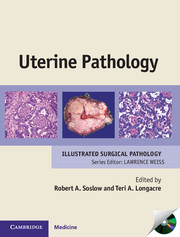Book contents
- Frontmatter
- Contents
- List of contributors
- Preface
- Acknowledgments
- 1 Cytology of the uterine cervix and corpus
- 2 Cervix: squamous cell carcinoma and precursors
- 3 Cervix: adenocarcinoma and precursors, including variants
- 4 Miscellaneous cervical abnormalities
- 5 Non-neoplastic endometrium
- 6 Endometrial carcinoma precursors: hyperplasia and endometrial intraepithelial neoplasia
- 7 Endometrioid adenocarcinoma
- 8 Serous adenocarcinoma
- 9 Clear cell adenocarcinoma and other uterine corpus carcinomas, including unusual variants
- 10 Carcinosarcoma
- 11 Adenofibroma and adenosarcoma
- 12 Uterine smooth muscle tumors
- 13 Endometrial stromal tumors
- 14 Other uterine mesenchymal tumors
- 15 Miscellaneous primary uterine tumors
- 16 Uterine metastases: cervix and corpus
- 17 Gestational trophoblastic disease
- 18 Other pregnancy-related abnormalities
- 19 Lynch syndrome (hereditary non-polyposis colorectal cancer syndrome)
- 20 Cytology of peritoneum and abdominal washings
- Index
- References
14 - Other uterine mesenchymal tumors
Published online by Cambridge University Press: 05 July 2013
- Frontmatter
- Contents
- List of contributors
- Preface
- Acknowledgments
- 1 Cytology of the uterine cervix and corpus
- 2 Cervix: squamous cell carcinoma and precursors
- 3 Cervix: adenocarcinoma and precursors, including variants
- 4 Miscellaneous cervical abnormalities
- 5 Non-neoplastic endometrium
- 6 Endometrial carcinoma precursors: hyperplasia and endometrial intraepithelial neoplasia
- 7 Endometrioid adenocarcinoma
- 8 Serous adenocarcinoma
- 9 Clear cell adenocarcinoma and other uterine corpus carcinomas, including unusual variants
- 10 Carcinosarcoma
- 11 Adenofibroma and adenosarcoma
- 12 Uterine smooth muscle tumors
- 13 Endometrial stromal tumors
- 14 Other uterine mesenchymal tumors
- 15 Miscellaneous primary uterine tumors
- 16 Uterine metastases: cervix and corpus
- 17 Gestational trophoblastic disease
- 18 Other pregnancy-related abnormalities
- 19 Lynch syndrome (hereditary non-polyposis colorectal cancer syndrome)
- 20 Cytology of peritoneum and abdominal washings
- Index
- References
Summary
INTRODUCTION
Endometrial stromal and smooth muscle proliferations are the most common mesenchymal proliferations in the uterus and, when combined, account for the vast majority of mesenchymal uterine processes in the cervix and corpus. However, there are a number of other mesenchymal lesions that the pathologist may encounter, either in the curettage or, more commonly, in the hysterectomy specimen. Most of these are benign, but occasionally lesions with intermediate or frankly malignant clinical behavior may also occur.
UTERINE TUMOR RESEMBLING OVARIAN SEX CORD TUMOR
Uterine tumors resembling ovarian sex cord tumor (UTROSCTs) are rare tumors that continue to pose diagnostic challenges for pathologists. Since Clement and Scully first drew attention to this group of unusual neoplasms, they have been variously grouped with the endometrial stromal, smooth muscle, or “other” categories of uterine mesenchymal tumors. Because they do not clearly exhibit smooth muscle or stromal features, we place them in the “other” category unless they exhibit significant endometrial stromal elements. Tumors with any significant endometrial stromal component are grouped with endometrial stromal tumors and classified as benign or malignant depending on the presence of infiltrative margins and/or vascular invasion (seeChapter 13).
Clinical characteristics
Uterine tumors resembling ovarian sex cord tumor occur in the reproductive and postmenopausal age groups. The clinical presentation is similar to that of uterine smooth muscle tumors. Patients often present with a uterine mass, abnormal vaginal bleeding, and/or pelvic pain. Some patients are asymptomatic.
- Type
- Chapter
- Information
- Uterine Pathology , pp. 264 - 281Publisher: Cambridge University PressPrint publication year: 2012



